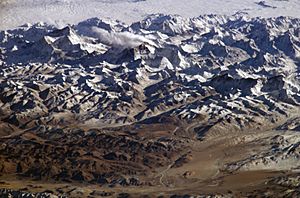Mountain range facts for kids

A mountain range is a group of many mountains that are connected. Think of it like a long chain of mountains! These chains often include high areas, mountain passes (gaps between mountains), and valleys.
Sometimes, a "mountain system" is used to describe a larger area. This area includes several mountain ranges and other related landforms. Even within one mountain range, the individual mountains might be made of different types of rock. This is because they can form in many ways, like through faults or volcanoes.
Contents
Where Are the Major Mountain Ranges?
Most of Earth's younger mountain ranges are found in two main areas. These are the Pacific Ring of Fire and the Alpide Belt.
The Pacific Ring of Fire
This area is known for many volcanoes and earthquakes. It includes the Andes mountains in South America. The Andes stretch along the Pacific Coast of North America, through the Aleutian Range, and into places like Kamchatka, Japan, and New Zealand.
The Andes are about 7,000 kilometres (4,350 mi) long. They are often called the world's longest mountain system on land!
The Alpide Belt
This belt stretches across Europe and Asia. It includes mountains in Indonesia and Southeast Asia. It goes through the famous Himalayas and ends in the Alps.
The Himalayas are home to the world's tallest mountains. This includes Mount Everest, which is 8,848 metres (29,029 ft) high!
Other Important Mountain Ranges
Not all major mountain ranges are part of these two big systems. For example, the Arctic Cordillera is the world's most northern mountain system.
If we include mountains under the ocean, the mid-ocean ridges are the longest mountain system on Earth. They stretch for about 65,000 kilometres (40,400 mi)!
How Mountain Ranges Are Divided
Many large mountain ranges have smaller ranges inside them. You can think of it like a family tree! A big range is the "parent," and the smaller ranges inside it are its "children."
For example, the Appalachian Mountains are a large parent range. Inside them, you'll find smaller ranges like the White Mountains and the Blue Ridge Mountains. The White Mountains are a "child" of the Appalachians. They even have their own "children," like the Sandwich Range and the Presidential Range.
How Mountains Affect Climate
Mountains play a big role in local climate and weather. They can cause a lot of rain or snow!
When air moves up and over mountains, it cools down. This cooling causes precipitation (rain or snow) to fall. As the air goes down the other side of the mountain (the leeward side), it warms up again. It also becomes much drier because it lost its moisture on the way up. This often creates a "rain shadow" on the leeward side, where it's very dry.
How Mountains Change Over Time: Erosion
Mountain ranges are always changing because of erosion. Erosion is the process where wind, water, and ice wear away rocks and soil. This happens while mountains are still growing taller and long after they stop growing. Eventually, mountains can be worn down into low hills or flat plains.
When mountains erode, the bits of rock and soil (called sediments) are carried away. These sediments often fill up the basins (low areas) next to the mountains. Over long periods, these sediments get buried and turn into sedimentary rock.
For example, the Rocky Mountains in Colorado were uplifted a long time ago. As they rose, about 10,000 feet (3,000 m) of rock was worn away by erosion. This material spread out as sand and clay across the Great Plains to the east.
Tallest Mountain Ranges
Here are some of the highest mountain ranges in the world:
| Name | Continent(s) | Country/ies | Highest point | Altitude (metres above sea level) |
|---|---|---|---|---|
| Himalayas | Asia | India, Nepal, Bhutan, China, Pakistan | Everest | 8848.86 |
| Karakoram | Asia | Pakistan, China, India | K2 | 8611 |
| Hindu Kush | Asia | Afghanistan, Pakistan | Tirich Mir | 7708 |
| Pamirs | Asia | Tajikistan, Kyrgyzstan, China, Afghanistan, Pakistan | Kongur Tagh | 7649 |
| Hengduan Mountains | Asia | China, Myanmar | Mount Gongga | 7556 |
| Tian Shan | Asia | China, Kyrgyzstan, Kazakhstan, Uzbekistan; | Jengish Chokusu | 7439 |
| Kunlun | Asia | China | Liushi Shan | 7167 |
| Transhimalaya | Asia | China | Mount Nyenchen Tanglha | 7162 |
| Andes | South America | Argentina, Chile, Peru, Bolivia, Ecuador, Colombia, Venezuela | Aconcagua | 6961 |
| Hindu Raj | Asia | Pakistan | Koyo Zom | 6873 |
| Alaska Range | North America | United States | Denali | 6194 |
| Saint Elias Mountains | North America | United States, Canada | Mount Logan | 5959 |
| Caucasus Mountains | Europe and Asia | Georgia, Russia, Azerbaijan | Mount Elbrus | 5642 |
Many of the Asian mountain ranges listed above formed over the last 35 to 55 million years. This happened when the Indian Plate crashed into the Eurasian Plate. The Indian Plate is still moving, so these mountains continue to grow taller every year! The Himalayas are rising the fastest.
Images for kids
-
The Andes, the world's longest mountain range on the surface of the Earth, have a dramatic impact on the climate of South America
-
Montes Apenninus on the Moon was formed by an impact event.
See also
 In Spanish: Cordillera para niños
In Spanish: Cordillera para niños
- Cordillera
- Drainage divide
- List of mountain types
- Lists of mountains
- Massif
- Mountain chain
- Mountain formation
- Ridge – an elongated mountain or hill, or chain of them



